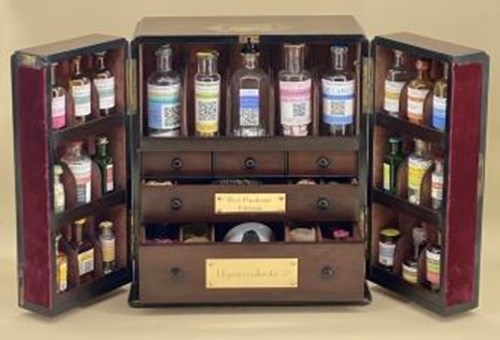Latest news from Anna Dumitriu, NCTC Artist in Residence

New commissions and exhibitions
Following on from my talk at the ECCO XXXIX Conference about my role as NCTC Artist in Residence I wanted to share an update about my latest projects and exhibitions.
I’ve been very busy since my last update, obviously the pandemic seriously affected my ability to work in labs but I’ve been able to create new works using some of the DNA from the fascinating NCTC 3000 project which was surplus to requirements.
I was commissioned by Medical Museion in Copenhagen to make a new artwork for a show called “The World is in You” at the Kunsthal Charlottenborg called “Hypersymbiotics: Post Pandemic Edition” a strange apothecary box, which is part of a series of works I’ve made on the theme of future medicine, synthetic biology and how we might harness various properties of bacteria. The piece highlights, for example, the antimicrobial properties of a Bacillus cereus donated to the NCTC in 1942 by Sir Howard Florey and also includes ‘Psychobiotics’, a plasmid, which when inserted into a probiotic E. coli will cause it to produce serotonin in the human gut – potentially making the consumer of the bacteria happy (although the piece is also clear about the risks). That part was a collaboration with the 2015 UCL iGEM Team but I was able to get the plasmid remade with support from Genscript for this new piece. The show continues until 16th January 2022.
“The Birth of Snowflakes”, is a new artwork commissioned by Birmingham Open Media for an exhibition called “Atmospheric Encounters” which has now toured to the SOLU Space of the Bioart Society in Helsinki where it will be on show until 20th November 2021. Clouds have their own microbiomes, made up of bacteria, viruses and fungal spores, which have been swept up from the ground by wind and through evaporation, in order to hitch rides around the planet. Water vapour can collect on these tiny specks of organic matter and seed ice crystals which fall as snow, their intricate crystalline forms being sculpted through the effects of microgravity as they plummet back to Earth. Each of the snowflakes in the series was algorithmically generated from scientific data in the form of the code numbers allotted to samples or fragments of pathogenic micro-organisms which can be acquired by laboratories for use in research, mainly the NCTC numbers. The snowflakes were 3D printed in copper which is known for its antimicrobial properties and have been impregnated with the DNA or RNA of the microbes from which they were generated. The invisible biological material on the 3D printed snowflakes is sterile, and there is no clear evidence that microbes falling as snow can cause disease. The snowflakes are exhibited with a fragment of unprocessed copper ore which connects to notions of ‘bioprospecting’ – the idea of ‘mining’ extreme environments, such as the stratosphere for bacteria with novel properties.
The Plague Dress, made with the NCTC as discussed in previous updates, is now part of a major exhibition entitled Contagious! at Rijksmuseum Boerhaave, in Leiden. It is a particularly suitable location for the work as the museum was formerly a ‘Pest House’ for the care of Plague victims and holds van Leeuwenhoek’s microscopes, through which he first saw bacteria, in their collection. In a twist of fate, this long planned exhibition opening was delayed due to the COVID-19 pandemic but was finally opened by the King of the Netherlands on 16th July 2020, who was pictured standing next to the Plague Dress. The show will continue until at least 9th January 2022.
I’m also very excited to be developing a project around the collateral effects of the pandemic with a focus on antibiotic resistance, an issue I am passionate about, and as part of this I will be continuing to work with the NCTC but also with the Thomson group at the Wellcome Sanger Institute to tell the story of NCTC 30, the world’s oldest living cholera dating from 1915. The strain is resistant to penicillin but pre-dates the ‘antibiotic era’ by many years, demonstrating that antibiotic resistance is something bacteria have done in the environment for eons, but now we select for it by placing them under increased environmental pressure. I’m looking forward to getting back in the lab as soon as possible.
Written by Anna Dumitriu, October 2021. Image: Hypersymbiotics by Anna Dumitriu photo credit Anna Dumitriu.jpeg
Further information
